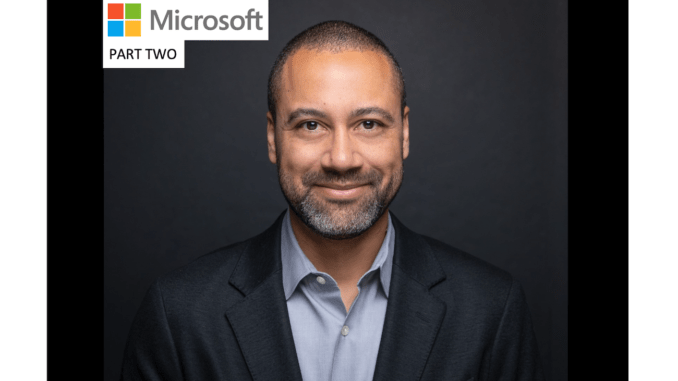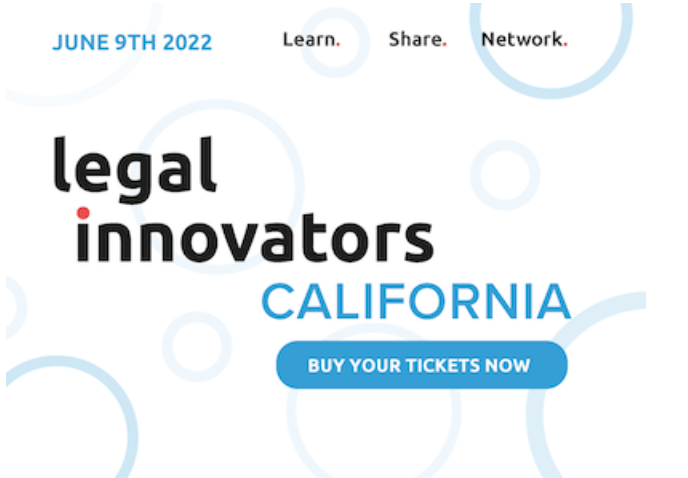
Microsoft is one of the largest companies in the world – so what they think about how legal needs are met really matters. Artificial Lawyer asked Tom Orrison, Director of Legal Operations, and Jason Barnwell (pictured), General Manager for Digital Transformation of Corporate, External, and Legal Affairs, a number of questions ranging from legal ops to legal tech. Here is Part Two of the interview. Once again, there is plenty of useful wisdom in their answers.
When it comes to driving efficiency with the inhouse legal team, what do you see as your top priorities? I.e. making use of CLM and ELM, doc automation, contract analysis / doc review tools? Do you use any of these and what really are the main things you focus on when it comes to driving efficiency in the legal team?
We try not to start the conversation with efficiency because our primary objective is creating value that delivers impact. Efficiency is a useful measure, but it is a tree, not the forest. Focusing on efficiency can produce a cost centre mentality that obscures smart investments and causes us to see ourselves as separate from the business.
We try to start with “What is the problem we are trying to solve?” We are experiencing exponential growth for legal services demand as a legal industry. We lack the capacity to serve that demand with our current models. This demand comes from our clients pursuing value creation in increasingly complex business spaces accelerated by machines. The net impact on legal includes increasing work volume, complexity, and velocity. To support this exponential growth, we must create leverage on our most constrained resource, human expertise, to allow our people to focus on the novel and complex issues where they deliver the highest impact. We need to invest in our people and systems to deliver more value that helps the business grow. Those investments must deliver efficiency, but we cannot cut our way to growth. Especially with the increasing impact we can deliver because of where our business is going.
Microsoft’s Corporate, External, and Legal Affairs organization is a large, diverse group. Many of our professionals are “drinking from the firehouse” because their work is so relevant. We are facing a period of transition that will see us focus more on empowering our people with common approaches and systems than individual flexibility autonomy that ignores context similarity. Historically, we employed high local empowerment for every aspect of how people worked. This allows smaller teams to move quickly and gives individuals flexibility and autonomy for how they do their work. A natural outcome is systems investments that focus on local maxima.
Exponential demand growth characteristics require scaled approaches focusing on global maxima that are harder to accomplish without consistency across our similar work. Every time someone does a common task in a different way, they introduce translation and coordination burdens on everyone else. Maintaining that flexibility and autonomy makes sense when we are exploring a new frontier for work that hasn’t been done before and we don’t understand what it is…yet. But, for the 80% percent of work that is of a known type, the more structure we can wrap around the work, the more we can honour the fundamental constraint of our scarcest resource, human expertise, by reducing translation costs and providing machines to support the work.
Three of our design principles are that experts (1) should not have to answer the same question twice, (2) should not be routers for known work, and (3) should remain in tools their primary tools with minimal training or switching. Creating human-centered efficiency is our top priority and we embrace the irony that we serve our people by removing choice from common work to give them back more time to focus on uncommon work.
We help our people adapt by investing in culture that prepares them for constant growth. When we try to bolt-on technology without complementary process and culture investments we do not create sustainable change. Tools and technology are amplifiers. They can help us achieve more when they augment our capabilities because our experts are involved in their co-creation.
The early phases of the digital transformation journey are often 20% technical development and 80% cheerleading. We want our people to desire the change. Cultural alignment combines with the necessary ingredients of incentives, skilling, and resources to accelerate our progress. And a fundamental component for building culture is storytelling. We curate and amplify stories that highlight individuals solutioning and building as our heroes who represent our future-state. This recognition reinforces the efforts of those who engage and attracts others to join the movement.
We embrace motivation has many sources. We must bring people along and ensure they understand the bigger context of what we are trying to accomplish that requires change and the smaller context of why it matters to them. If we do not honour the “why” of the change and “what’s in it for me,” we do not access intrinsic motivation. At best we get compliance – the least effort required to avoid a policing effort. We invest a lot to activate intrinsic motivation because it produces more engagement that ultimately produces more value and impact from our investments, including efficiency.
And, if I can add one last question: how much impact has the legal ops movement had on how Microsoft’s legal team now works?
Legal operations has changed how we do our work so we can contribute more meaningfully to the business’ value creation process. Many of our legal professionals may not perceive the extent of that change because it has been a constant evolutionary process and many of the operations elements that deliver excellence at-scale are embedded and not called “legal operations professionals.” They are business managers, program managers, business analysts, and legal professionals who transform how we do our work.
This evolution comes from business demands for more value built upon improved velocity, outcome quality, and efficiency. It includes capabilities that people would conventionally ascribe to operations like the ability to manage millions of contracts with a team of a few people. It also includes less conventional capabilities like the ability to develop custom line of business applications using low and no-code tools that help our department drive our strategy development lifecycle. We still have a long way to go because even as we advance the horizon before us extends.
We will see increasing need for legal operations capability and impact because we serve a business with exponential growth ambition and capability. Our legal professionals must deliver known work in a patterned and systematized form to achieve scale. This will require skilling in design thinking that reimagines how we deliver our common services through machine-powered-experiences. Microsoft’s open source practice is an example that has scaled to service 1,000x volume over the last decade without using more human capital, building on operations principles. We are currently pursuing an opportunity for a similar work pattern, learning from the open source team’s approach. Our goal is to reduce the median work time from 3 days to 3 minutes. This is transformative change, and it is not comfortable. But these kinds of outcomes build upon our operations foundation and express the kind of value we want to bring to our business.
The movement always starts with culture that builds the new normal. People are busy and need help perceiving the value of the investments we make that change their experience. Legal operations is no different because for the uninitiated the concepts and approaches are foreign. Our experience suggests that “legal operations” might be a transient term. And a decade from now it’s just how you do legal work.
Thanks very much Jason and Tom!
—
Conference Promotion:

Legal Innovators California – June 9, San Francisco – All-Day, In-Person Legal Innovation Conference.
If you found this interesting then come along to Legal Innovators California conference on June 9, in San Francisco, where we will be exploring a range of subjects, from legal ops to legal tech and much more, with a range of great speakers from across the industry.
Ticket information can be found here.

I like the concepts of primary focus is on human expertise while tools are augmenters because human expertise will remain while tools will become outdated or obsolete as the technology behind them advances.
Spending significant time on messaging and buy-in then makes sense since humans need to see the value of wielding and exploiting tools.
Also, humans need to look at themselves as a tool that can continuously adapt, if they so choose.
Which begs the question, what is human expertise, after all?